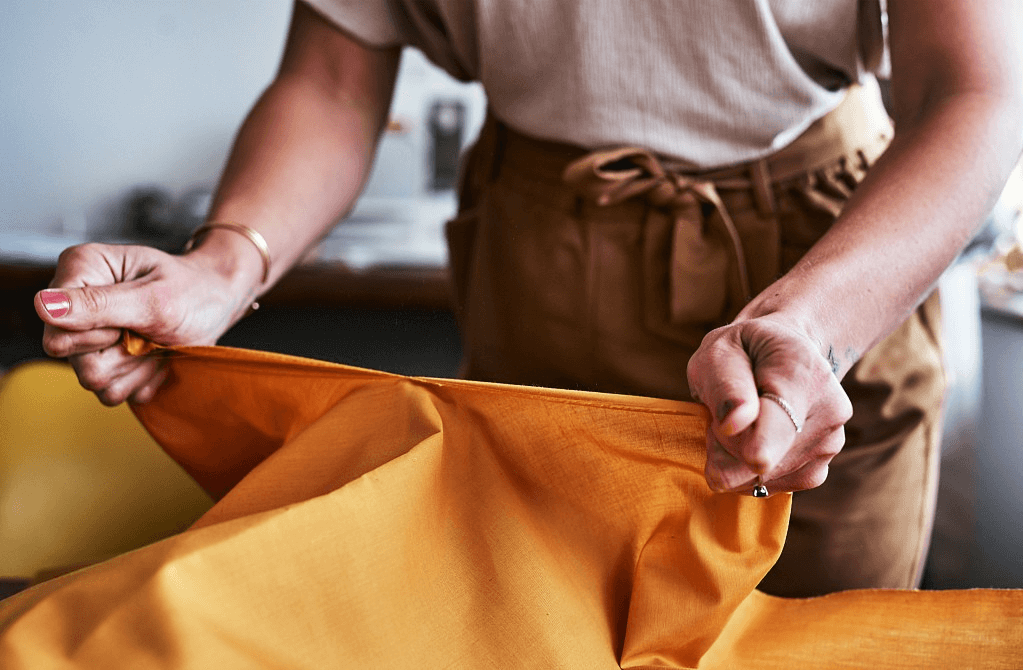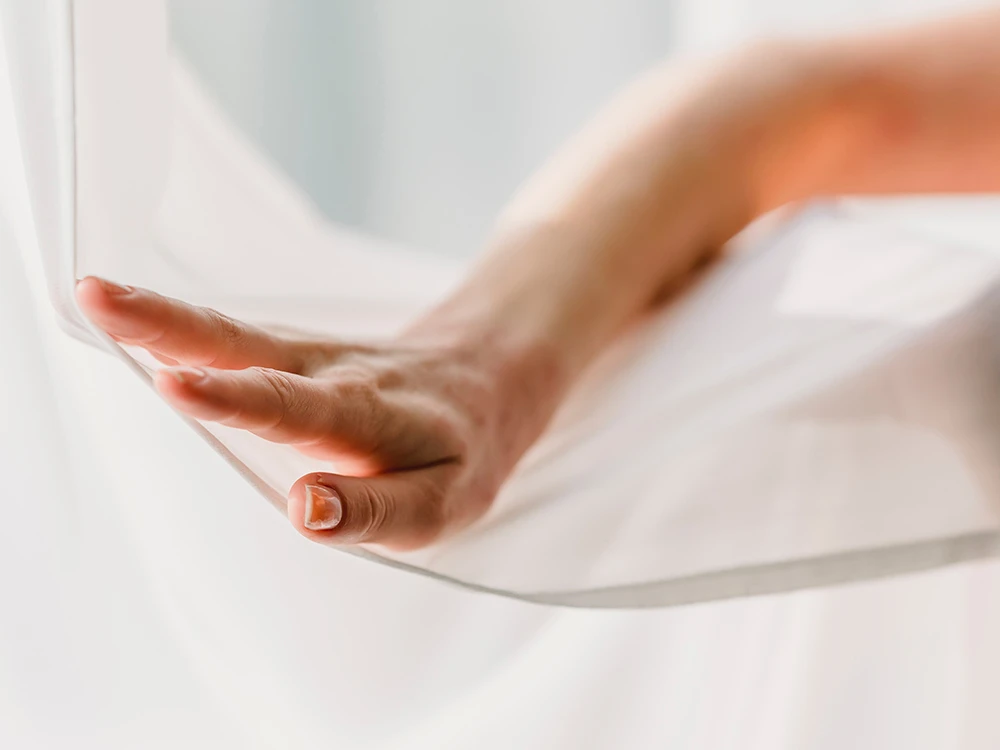Tearing, or fabric tearing, happens when a load affects the fabric’s local yarns. In use, clothes can get caught on objects. This can pull off the local yarn in the fabric. It can form a strip or triangular tear, which is a type of fabric fracture.
Definition of fabric tear strength
Fabric tear strength is its ability to resist rupture from a vertical tensile force. This strength depends on the interlock of the transverse and warp yarns of the fabric, and the fibres’ properties.
Factors affecting fabric tear strength
1) Raw material
Different raw materials vary greatly in their resistance to tearing and stretching. Of chemical fibres, nylon has the highest tear strength. Then, it’s polyester. Of natural fibres, hemp is the strongest, then cotton.
2) Yarn properties
Tear strength in textiles is roughly proportional to the yarn’s breaking strength. It is also closely related to the yarn’s breaking elongation. A large breaking elongation of the yarn means a high force. The force triangle bears the yarn’s root number, so it tests the textile’s tearing strength. The friction between the warp and weft yarns reduces the textile’s tear strength. With high friction, the two yarn systems can’t slide. The force triangle shrinks, and fewer yarns bear the external force. So, the textile’s tear strength is low. Therefore, the yarn twist, surface shape of the textile also has an effect on the tearing strength.
Fabrics with high yarn elongation are resistant to tearing. Fabric tear strength roughly matches a yarn’s breaking strength at a fixed point. Yarn breaking elongation affects the size of the force triangle and the number of yarns in it. A higher elongation means a bigger triangle and stronger fabric. But, it also stresses the yarns. So, synthetic fibre fabrics have a better tear strength than natural and man-made ones. Synthetic fibre blended with natural fibre can improve the tearing strength.
① Yarn density: thicker yarn has better tearing resistance and tensile strength.
② The yarn can be filament or staple. Manufacturers can make filament into yarn for textiles. But, you must twist the staple to make yarn. So, staple is weaker than filament.
③Twist of yarn: it can help short fibre yarn or filament hold together. This improves the fabric’s strength, elasticity, and tear resistance.
The tearing strength of fabric is about proportional to the breaking strength of yarn.
3) Textile Organisation
Textile organisation has a significant effect on textile tear strength. If other conditions are the same, the three original fabrics differ in tear strength. Plain has the lowest, satin the highest, and twill is in between. The effect of textile density on the tear strength of textiles is more complex. If the yarn thickness is the same, the tear strength of the textile is higher than its density. For example, gauze is not easy to tear. When the density of the warp and weft to close, the warp and weft tear strength close. If the warp is denser than the weft, its tear strength is greater. For example, poplin fabric easily develops cracks in the warp. This is because the weft density is much lower than the warp’s. The weft’s tear strength is also much lower than the warp’s.
① Different fabric organizations have different yarn interlacing.
This alters the degree of slip between the yarns. Usually, the more the fabric interlaces yarns, the harder it is to slide the warp and weft yarns. This makes the force triangle smaller and reduces the number of yarns in it. As a result, the fabric’s tear strength is lower. So, plain tissue fabric has low tear strength. Square flat tissue fabric is stronger. Twill and satin tissue fabric fall in between the two.
② Fabric density depends on the yarns’ free space and their friction.
With the same yarn thickness and fabric structure, the fabric has a lower warp and weft density. It has fewer friction points, so it slips easily. This increases the force triangle. More yarns are in the area of the force, so the tear strength is greater. When the warp and weft density is close, their tear strengths are also close. If the warp to weft density ratio is greater than 1, the warp will be stronger. But, if the difference is too large, the tear may not follow the cut. If the fabric’s warp and weft density is too high, friction will increase. It can displace the yarns a little. This will reduce the number of stressed yarns in the triangle, hurting tear strength.
Weaving shrinkage affects a fabric’s tearing strength in two ways. First, it increases the fabric’s elongation. This raises the force triangle and the number of stressed yarns. It boosts tearing strength. Second, it increases the yarns’ bending. This raises friction and reduces their mobility, lowering tearing strength. But, in general, a higher density, within a range, is best. It increases weaving shrinkage and improves fabric tear strength.
The structure of the fabric includes warp and weft density and fabric texture. The higher the warp and weft density, the stronger the fabric. It means the yarns are more tightly interwoven. Different grain designs also affect the tear strength of the fabric.
4) Fabric density
The effect of fabric density on its tear strength is complex. For low-density fabrics, as density increases, tear resistance improves. However, as the fabric’s density gets very high, its tear strength decreases.
5) Fabric finishing
In cotton textiles, the yarn of the withered rubber fibre elongates. After resin finishing, the yarn’s elongation decreases. The textiles become more brittle, and their tear strength drops. The degree of decline with the use of resin type, processing technology.
After the resin finishing of cotton, viscose fibre textiles, tear strength decreased. Especially cotton fabrics. This is because, after resin finishing, their strength and elongation at break fell. Viscose fibre fabrics are now stronger. But, their elongation at break decreased.
6) Test method
Different test methods give different tear strength results. They are not comparable. Because the tearing method is different, the tearing triangle has obvious differences. Also, tear strength is as affected by temperature and humidity as tensile strength is.
7) Fibre type
Fibre type and fibre dosage is one of the determining factors of the tear strength of fabrics. Natural fibres usually have a weaker tear strength. Man-made fibres have a higher tear strength than natural fibres. Different amounts of fibres also affect the tear strength of the fabric.
8) Textile Process
Textile process refers to the entire production process from yarn to fabric. Different textile processes affect a fabric’s tensile and tear strengths. For example, the yarn processing, the loom type, and the settings affect the fabric’s tear strength.
Principles of textile tearing:
This paper uses the single stitch method to discuss tearing and breaking of textiles. It focuses on tearing along the weft direction and breaking of the warp yarns. In single seam tearing, the split forms a force triangle. As the stressed weft yarns in the specimen separate, the unstressed warp yarns start to slide relative to the weft. They then come closer together, forming a triangular region. At the bottom of the tear, the warp yarns in the triangle of force must bear the tensile force. The first warp yarn at the bottom edge of the triangle is subject to the greatest force. The other warp yarns face a gradually weakened load. Frictional resistance between the yarns limits the sliding. When sliding, the yarn’s tension and elongation both rise sharply. The first warp yarn at the bottom edge of the force triangle broke when it deformed to its fracture limit. The second warp yarn then transformed into the state of the first warp yarn before it fractured. This repeated, with the warp yarns breaking one after another. This created a knife-like fracture surface.
A textile tensile testing machine tests woven fabrics’ tear strength. It uses the Elmendorf method. It can also test thick paper, plastic cloth, and electrical tape.
Methods to improve the tear strength of fabrics
1. Use of high-quality fibres
You can improve the tear strength of fabrics by selecting high-quality fibres. Blending with high-performance fibers boosts the fabric’s tear strength. It does this by increasing the yarn strength.
2. Improve the spinning process
Using the right yarn processing, loom type, and machine settings can improve the tear strength of the fabric. It will do this by improving the textile process. Reduce the friction between fibres to make the fabric smoother. To improve yarn movement, change the fabric’s structure. This will boost tearing performance. It will increase the number of stressed yarns. Using tear strength enhancers, like a non-ionic polyethylene emulsion, can protect the fiber. It will reduce fabric wear and rupture.
3. Adjustment of fabric structure
Adjusting the warp and weft density and grain design can improve the tear strength of the fabric. Increase the warp and weft density of the fabric. Increase the flexural wave height. In the tearing process, increase the number of yarn roots in the fabric’s force triangle. Also, increase the weaving shrinkage of the yarn and the number of force roots. These changes will improve the fabric’s tearing performance.
ChiuVention Elmendorf Tear Tester
The Elmendorf Tear Tester is also called the Elmendorf Tearing Tester or Tearing Strength Tester. It is one kind of tearing tester that tests the tearing strength of fabric. It uses a pendulum tearing method. The pendulum falls from a set height. It turns stored energy into motion. The Tearing Strength Tester cuts fabric and measures the force needed to tear it to a certain length. This force can be used to find the fabric’s tear resistance.
The Tearing Tester is on sale; welcome to contact us for a quotation and a big discount.
Conclusion
The main textiles needing high tear strength are workwear and outdoor workwear. Also, labour wear and labour gloves. These garments must provide a level of protection and comfort in special environments.
Fabric tear strength is a key performance indicator of fabrics. It mainly depends on the fibre type, textile process, and fabric structure. We can improve fabrics’ tear strength to meet different needs. To do this, we will use high-quality fibers, improve textile tech, and adjust the fabric structure.
For more information on textile testing methods/standards
or textile testing machines, contact us:
What’s App: +86 180 2511 4082
Tel: +86 769 2329 4842
Fax: +86 769 2329 4860
Email: [email protected]


